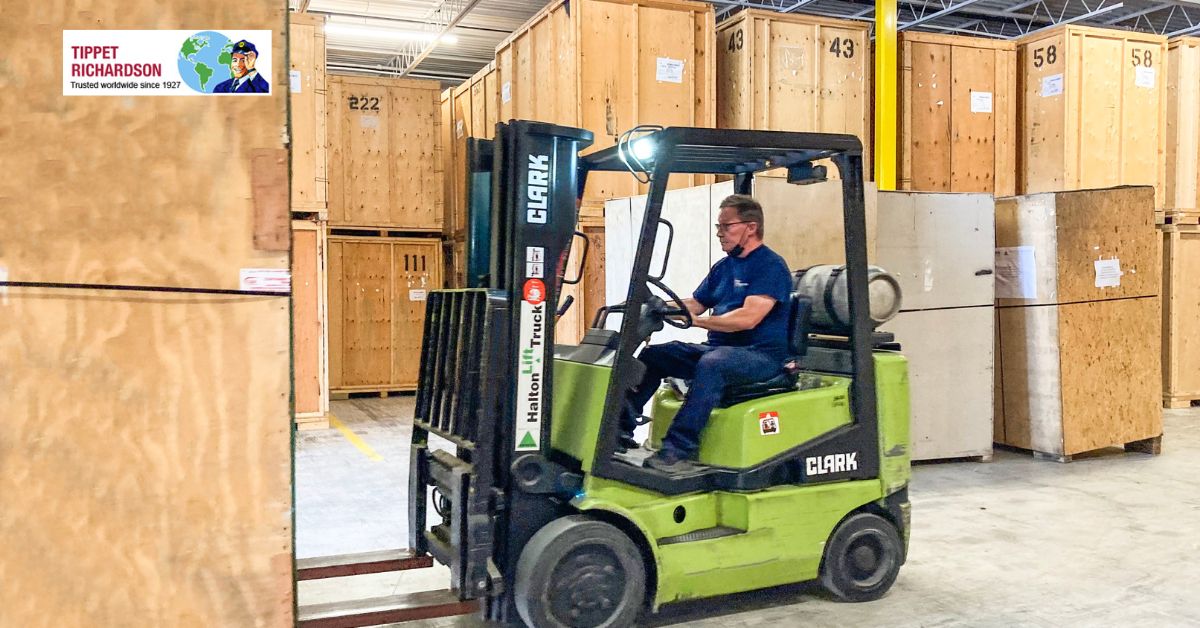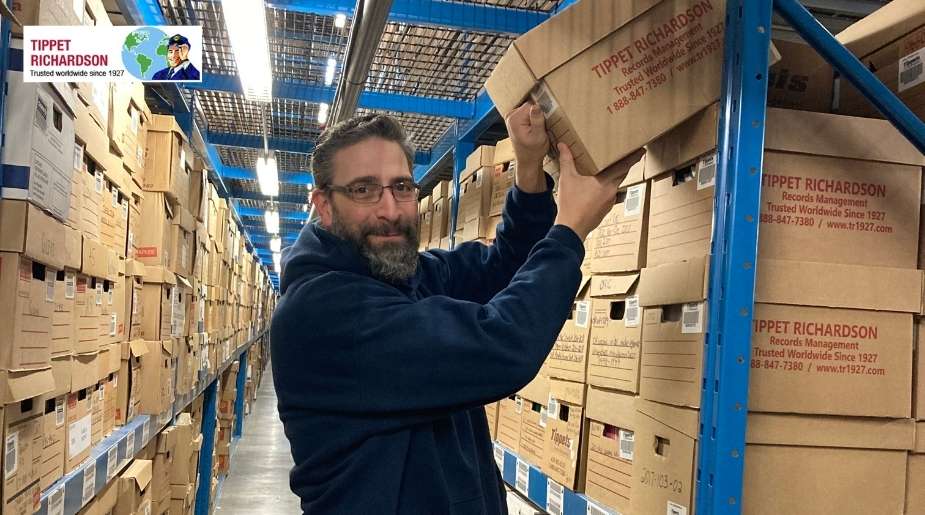When preparing for long term storage of household items, understanding the nature of extended storage is crucial for protecting your belongings. Long term storage typically refers to keeping household goods securely stored for several months to years. Unlike short-term holding, this requires a more meticulous approach to packing and environmental control to prevent deterioration over time.
Careful preparation becomes essential because household items face different challenges during long durations. Factors like temperature fluctuations, humidity, and exposure to pests can gradually damage furniture, electronics, textiles, and other valuables. This is why the long term storage of household items cannot rely on makeshift or temporary methods — it demands durability, moisture prevention strategies, and a controlled environment to maintain quality and longevity.
This is precisely where professional pallet storage services provide considerable advantages. Tippet Richardson’s pallet storage facilities in Toronto are designed with long term storage in mind. Each pallet is securely wrapped and positioned to allow proper air circulation and limit contact with surfaces that might harbour moisture or pests. Our climate-controlled warehouses stabilize temperature and humidity, reducing risk factors that commonly cause material degradation in long-term storage.
Furthermore, the use of pallet storage rather than conventional methods allows for organised stacking and efficient use of space while safeguarding items. The pallets create a barrier between your household goods and the floor, preventing water damage from potential leaks or floods, a critical feature when considering moisture prevention for long-term storage.
Still, successful long term storage requires anticipating and managing key challenges. Moisture is one of the greatest threats: constant exposure to dampness or fluctuations in humidity can cause mould, mildew, rust, or warping. Additionally, pests such as rodents or insects may infiltrate improperly sealed packages, causing irreversible damage. Finally, material degradation from dust, light exposure, and natural elements can slowly erode the condition of items.
By choosing Tippet Richardson’s expert services in Toronto, you gain access to a storage solution that actively addresses these concerns. Our professional process combines durable packing guidance, advanced moisture prevention measures, and secure handling to ensure your household items remain in pristine condition throughout their stay. Understanding these critical aspects of long term storage of household items not only prepares you to pack wisely but also helps you appreciate the value of using trusted, experienced storage partners.
Read Also: Why Choose Storage Solutions for Fragile Household Goods
Durable Packing Tips for Long Term Storage of Household Items
Successful long term storage of household items begins with durable packing techniques that provide maximum protection against the challenges of extended storage. Choosing the right materials, packing carefully, and keeping track of your items will help maintain their condition and simplify retrieval when needed. This section outlines essential durable packing tips tailored for long term storage.
Selecting High-Quality Packing Materials
Choosing the appropriate packing materials is the foundation of durability. For long term storage, not all boxes and wraps are equal. Sturdy, double-walled corrugated cardboard boxes offer more resistance to crushing and moisture ingress than standard single-layer boxes. Reinforced packing tape ensures sealed boxes remain intact during transport and storage. Heavy-duty bubble wrap or foam padding protects fragile items from shocks and vibrations.
Archival-quality packing paper is ideal for wrapping delicate antiques, artwork, or photographs, as it is acid-free and prevents yellowing or degradation over time. Avoid using newspaper for wrapping because the ink can transfer and cause permanent stains. When selecting containers for textiles or clothing, breathable fabric bags or cotton sheets are preferable to plastic, which can trap moisture.
Tippet Richardson in Toronto recommends sourcing packaging materials that explicitly state durability and moisture resistance, as these are critical for long term storage of household items to reduce the risk of damage over months or years.
Proper Packing Techniques to Prevent Damage
Even the best materials will not protect your belongings without proper packing techniques. Start by disassembling large furniture where possible, removing legs, cushions, or glass panels, and wrapping each piece separately in protective materials. This reduces bulk and lowers the risk of scratches or cracks.
For fragile items such as glassware or ceramics, wrap each piece individually in bubble wrap or archival paper, then nest them carefully inside boxes with cushioning materials filling all gaps to prevent movement. Place heavier items at the bottom and lighter, more delicate items toward the top, distributing weight evenly to avoid crushing.
When packing boxes, avoid overfilling them. Boxes should close easily without bulging, allowing tape to seal edges securely. Clearly label the contents on all sides and specify if the box contains fragile items to facilitate careful handling.
Packing with the end goal of long term storage in mind means investing extra time to double-wrap and reinforce boxes, ensuring they withstand the pressures and environmental factors found in pallet storage facilities.
Labelling and Inventory Management
Clear and detailed labelling is often overlooked but vital for long term storage of household items. Each box or pallet should be marked with a brief description of its contents, the room it belongs to, and special handling instructions if needed.
Maintaining an inventory list alongside photos of packed items provides a handy reference to track what is in storage without opening boxes repeatedly. This helps avoid unnecessary disturbance that could affect the packaging’s integrity or expose items to moisture.
Tippet Richardson offers guidance to customers on creating efficient inventories and labelling systems that integrate with their pallet storage process in Toronto. This approach not only streamlines future access to your belongings but also supports consistent inspection routines ensuring stored items remain in prime condition.
Incorporating durable packing tips, along with proper labelling and inventory methods, prepares your household goods comprehensively for the demands of long term storage. These steps minimize damage risk and facilitate smooth management throughout the storage period, setting the stage for effective moisture prevention and additional care measures detailed in the next section.
Moisture Prevention Strategies for Safe Household Storage
When preparing for the long term storage of household items, moisture prevention is a critical factor in protecting your belongings from lasting damage. Moisture can lead to mold, mildew, rust, and warping, all of which degrade the condition and value of stored goods. Understanding how to identify risks, use moisture-control tools effectively, and prepare items properly ensures your possessions remain safe throughout their time in storage.
Identifying Moisture Risks in Storage Environments
Moisture can infiltrate storage spaces in subtle but damaging ways. Fluctuations in humidity caused by changing weather or poor ventilation often lead to condensation inside boxes or wrapping materials. This dampness creates an environment conducive to mould growth and fabric degradation. Toronto’s seasonal variations make it especially important to anticipate these moisture risks when storing household items long term.
Storage environments may also experience water intrusion from leaks, floods, or plumbing issues. Even with well-maintained facilities, transient moisture risks remain a concern. Additionally, poorly sealed boxes or packaging can allow microclimates that trap humidity, increasing exposure.
Identifying these moisture risks means assessing the storage environment carefully and selecting storage solutions, such as Tippet Richardson’s pallet storage in Toronto, that offer climate control and protective barriers to minimise exposure.
Using Desiccants and Moisture Absorbers Effectively
Desiccants and moisture absorbers are valuable tools in maintaining dry conditions inside storage packaging. Common types include silica gel packets, clay-based absorbers, and calcium chloride products. These agents work by attracting and holding moisture from the air within enclosed spaces.
For long term storage of household items, it is best to place desiccants inside boxes and wrap containers where moisture buildup is most likely, such as around textiles, electronics, or paper goods. Toward larger items like furniture, placing moisture absorbers near the base or inside drawers can reduce internal humidity levels.
It is important to replace or recharge desiccants periodically if possible, especially for storage exceeding several months. When using Tippet Richardson’s pallet storage services, staff can advise on the appropriate type and placement to complement our climate-controlled facilities, enhancing moisture prevention.
Preparing Items to Resist Moisture
Before packing, properly preparing each item is essential for effective moisture prevention. This includes thorough cleaning to remove dirt and organic material that can foster mould, followed by complete drying to eliminate residual moisture. Dampness trapped inside packaging can quickly lead to mildew.
Sealing items with moisture-resistant materials also helps. For example, wrapping wooden furniture in breathable furniture covers or acid-free paper protects against moisture without trapping humidity. Electronics should be stored in original packaging or plastic bags with silica packets, ensuring no moisture is present before sealing.
Clothing and textiles benefit from being clean and completely dry; using cotton bags instead of plastic prevents condensation. Tippet Richardson’s experienced team provides guidance on these preparation steps to help clients in Toronto achieve optimal moisture prevention when storing household goods long term.
Incorporating these moisture prevention strategies alongside durable packing tips maximizes protection, ensuring your household items emerge from storage in excellent shape. The next section will explore specialized packing advice tailored for common household items, building on this foundation to further refine your packing approach.
Read Also: The Best Way to Organize Your Seasonal Household Goods Storage
Specialized Packing Advice for Common Household Items
Packing household items for long term storage requires tailored approaches to address the unique vulnerabilities of various categories. Electronics, furniture, and textiles each face distinct risks during storage, so applying specialized packing techniques ensures better protection and longevity. These durable packing tips, combined with effective moisture prevention, form a comprehensive strategy to keep your belongings safe.
Protecting Electronics and Appliances
Electronics and appliances are among the most sensitive items for long term storage of household items. They can be damaged by moisture, dust, and physical shocks if not packed properly. Before storage, unplug all devices, remove batteries, and clean them thoroughly to avoid residue buildup or corrosion. Allow each item to dry completely.
Wrap electronics in anti-static bubble wrap or cloth to prevent dust accumulation and static damage. Where possible, store them in their original packaging, which is designed to protect delicate components. Including silica gel packets inside sealed containers helps absorb moisture, further protecting sensitive circuits and displays.
For appliances, ensure they are clean and dry, especially refrigerators or washers. Leave doors slightly open if recommended to prevent mildew from forming inside. Tippet Richardson’s pallet storage in Toronto accommodates these needs with secure, climate-controlled spaces that complement these packing methods.
Safeguarding Furniture and Wood Items
Wood and furniture require specific care to prevent warping, cracking, and pest infestation during long term storage of household items. Start by cleaning and polishing wood surfaces to seal pores and reduce moisture absorption. Avoid using plastic wraps directly on wood, as this can trap humidity and cause damage.
Instead, wrap furniture in breathable cotton blankets or specialized furniture covers that protect from dust and bumps while allowing air circulation. Disassemble large pieces when possible, storing parts separately with proper cushioning. Placing pest deterrents near wooden items can further safeguard against insect damage.
Tippet Richardson’s experienced team in Toronto recommends these treatments to customers storing valuable furniture, ensuring your wood items retain their original beauty throughout the storage period.
Storing Textiles, Clothing, and Linens
Textiles and clothing require careful packing to maintain fabric quality and avoid moisture buildup. Unlike plastic, breathable containers such as cotton garment bags, fabric storage bins, or wrap-around acid-free tissue paper prevent condensation that fosters mould and mildew.
When packing clothes, fold them loosely rather than rolling to reduce creases and allow airflow. Ensure all fabrics are clean and fully dry before storing to eliminate sources of pests like moths or fungi. For linens and other fabrics, layering with moisture-absorbing packets keeps them safe in enclosed spaces.
Maintaining these careful packing choices enhances moisture prevention efforts and extends the lifespan of delicate textiles during extended storage. Tippet Richardson supports clients in Toronto with advice tailored to preserving fabric-based household items in our pallet storage facilities.
Applying these specialized packing tips—focused on electronics, furniture, and textiles—boosts the effectiveness of your overall strategy for the long term storage of household items. This prepares you for safe transport and storage, topics we will cover next, highlighting how Tippet Richardson manages these processes professionally in Toronto.
You May Also Like: When Should You Use Short Term Household Storage in Toronto
Transporting to and Accessing Your Pallet Storage in Toronto
Ensuring your household items arrive safely and remain accessible throughout their time in storage is a crucial part of the long term storage process. Tippet Richardson’s expertise in pallet storage makes this transition smooth and reliable. From secure loading practices to transparent access protocols, understanding the full storage journey helps you prepare and stay informed.
Safe Loading Practices for Long Term Storage
Proper loading techniques are vital to maintain the integrity of your packed household goods during transport and into pallet storage. Each pallet load should be carefully assembled with balanced weight distribution to prevent tipping or crushing. Tippet Richardson’s skilled movers in Toronto use heavy-duty shrink wrap and strapping to firmly secure boxes and items, avoiding any shifting or damage.
Furniture and fragile items require additional cushioning and bracing before being palletized. Pallets themselves act as a protective base, keeping goods off the ground and reducing moisture exposure—one of the essential moisture prevention methods for long term storage of household items.
During transport, experienced handlers ensure gentle manoeuvring and stable stacking inside the moving vehicle to preserve the condition of your belongings. Communicating detailed inventory and labelling clearly with the movers also supports careful handling.
Overview of Tippet Richardson’s Pallet Storage Process
When your household goods arrive at Tippet Richardson’s Toronto pallet storage facility, they undergo a meticulous intake process designed to maximize protection and organisation. Upon arrival, pallets are inspected for secure packing and then placed in climate-controlled environments that mitigate temperature and humidity fluctuations known to harm stored items.
Our pallet storage method involves stacking goods on high-quality pallets with sufficient spacing around them to allow air circulation, further aiding moisture prevention. Throughout their stay, your belongings remain under continuous surveillance and upkeep, ensuring they remain in the same well-preserved condition as when they arrived.
The entire process is transparent and customer-focused. Clients receive detailed documentation about their stored goods and can request updates or adjustments as needed, making Tippet Richardson a trusted partner for long term storage in Toronto.
Planning for Periodic Access and Inspections
Regularly checking on your stored household items can prevent surprises and help maintain their condition over time. Tippet Richardson facilitates scheduled access visits, so you can inspect, rearrange, or retrieve items without disrupting other stored goods.
When planning visits, consider bringing inventory lists and labels with you to efficiently locate specific boxes or pallets. During inspections, look for signs of unexpected moisture, pest activity, or packaging deterioration and communicate any concerns promptly to Tippet Richardson’s team.
Periodic inspections also allow you to refresh moisture absorbers or reinforce packaging if your storage duration extends, maintaining the durability of your packing and ongoing moisture prevention.
By partnering with Tippet Richardson in Toronto for your pallet storage needs, you benefit from expert handling from transport through ongoing access, ensuring your long term storage of household items is convenient and secure.
Wrapping Up
Proper packing and meticulous preparation form the foundation of successful long term storage of household items. Investing time in durable packing tips—from selecting quality materials to applying expert wrapping techniques—combined with effective moisture prevention strategies, ensures your belongings remain safe, intact, and preserved throughout their storage period.
Choosing the right storage partner is equally important. With Tippet Richardson’s premium pallet storage solutions based in Toronto, you gain more than just space; you receive trusted expertise and climate-controlled environments designed specifically for long term household goods storage. Our careful handling, secure stacking, and ongoing monitoring mean your valuables are guarded against common storage hazards like moisture, pests, and physical damage.
Whether you are facing a move, downsizing, or simply need reliable, long term storage in Toronto, partnering with Tippet Richardson provides peace of mind that your household items are in experienced hands. Feel confident that when it comes time to retrieve your belongings, they will be ready—protected and well-cared-for exactly as you packed them.
Contact Tippet Richardson today to learn how we can assist you with the long term storage of household items. Together, we can make your storage experience smooth, secure, and worry-free from start to finish.





